 |
Home | Search | Browse | About IPO | Staff | Links |
 |
Home | Search | Browse | About IPO | Staff | Links |
Jerry M. Landay 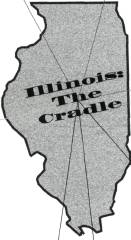
Modern radio and television—the ubiquitous telemedia—cast their content around the world using satellites in synchronous orbit. They collect ready audiences in an instant or those who want to be amused, or who seek news and information that may alter their lives, or consume the latest bargains, enjoy music, or escape from their troubles. And for that reason, businessmen, politicians, and advertisers seek access to the electric media. In the distinct minority today are public activists who believe that those with needs not addressed by commercial owners and operators deserve alternative program sources dedicated to the public interest to inform, to educate, to enlighten. Guglielmo Marconi, the Italian who invented radio in the 1890s, wasted little time exploiting his invention for wealth and power. He sought a monopoly over the airwaves. He offered radio as a commercial carrier of personal messages from ship to shore, as a beacon of distress by ships in trouble, as a transmitter of news to client newspapers, and as a means by which imperial admirals could send orders to their dispersed fleets. The United States resisted letting a foreign company maintain a monopoly on such a powerful force as radio. The United States Navy, which made use of radio during World War I, tried to create its own peacetime monopoly over American broadcasting. In response, Congressman William S. Greene of Pennsylvania warned his colleagues against the necessity for one person or agency "to own all the air in order to breathe." Congress agreed, and blocked the navy's attempt to harness radio's power directly. Undeterred, the navy quietly mobilized a cartel of private corporations involved in manufacturing electric products. They included General Electric, Westinghouse Electric, and the Radio Corporation of America (RCA). They acquired radio stations to carry their programs to induce audiences to buy their radio sets. They created networks to reach national audiences, and then augmented their profits by offering sponsorships to advertisers. 3 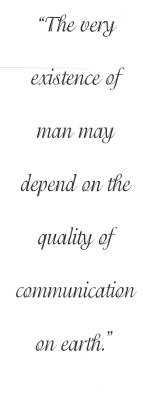
Others saw radio not as a profit center but as a tool of outreach and enlightenment for universities, churches, municipalities, and libraries seeking to extend their range beyond their physical domains. In Britain in the early 1920s, the British Broadcasting Corporation (BBC) had been created as a noncommercial program provider, financed directly by users through a tax on radio sets. Its mission was to disseminate the highest values of British culture through its programs. But in the United States, broadcasting was destined to be largely commercial. The government, through the Federal Radio Commission, which in 1934 became the Federal Communications Commission (FCC), drove most noncommercial broadcasters off the air through bureaucratic licensing procedures. While commercial licenses issued by the FCC required stations to serve "the public interest," the principle was seldom honored in practice. So-called public-service programs served as window-dressing, but they were largely substandard, mostly aired in the late night or early morning when audiences were meager. Between 1921 and 1936, some 200 stations had been established by educational institutions. But by 1936,164 of them had been driven off the air by under-financing or the economic Depression, and their assigned places on the radio dial sold off to commercial interests. From educators and the public, pressure for better programs grew, and activists formed non-profit organizations to agitate for better radio. They asked the federal government to reserve frequencies for stations not only for educational purposes, but to supply programs of quality to an audience poorly served by the commercial industry. It was not until after World War II in the 1940s that the FCC first reserved new radio channels on the FM band for educational stations. 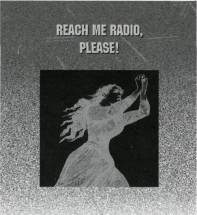
Could noncommercial, educational broadcasting prevail in a largely commercial environment? Wilbur Schramm, a brilliant communications scholar at the University of Illinois, thought that it could, provided that educational broadcasters were mobilized to fight for enlightened programming, and that funding sources were persuaded to underwrite it. Schramm was a visionary. He believed that broadcasting was more than an amusement carrier. In the hands of dedicated broadcasters, it was an effective instrument of teaching in the classroom and the home—"a powerful tool of large audience instruction, perhaps the greatest tool of all time," he said. "The very existence of man," wrote Wilbur Schramm, "may depend on the quality of communication on earth." In whose hands did that power belong? One of the organizations founded to advance the cause of educational, noncommercial radio was the National Association of Educational Broadcasters. The NAEB began in 1925 as an informal association of managers of university radio stations—mostly in the Midwest. They offered regular farm-to-market reports, agricultural information, "how-to" programs, children's programming, and generous doses of culture. According to its 1936 program log, WILL, licensed to the University of Illinois, aired a varied diet for example, Rural Life Review, Market Topics, Theatre Chats, Language Lessons in French and Spanish, Parent-Teacher Forum, and, for kids, Stories 'N Stuff." 4 Schramm identified the NAEB as the collective instrument upon which an organized national force of noncommercial stations could be built. As the first step, he invited NAEB members to hold their annual convention at the University of Illinois in the summer of 1948. In July the following year, he invited a group of thinkers and activists to two weeks of brain-storming at a country estate that a wealthy Chicago arts patron, Robert Henry Allerton, had deeded to the university. "The Farms," as Allerton called it, on the banks of the Sangamon River near Monticello, Illinois, consisted of fifteen hundred acres of magnificent grounds, formal gardens, nature preserves, and an elegant manor house where the sessions were held. Some twenty-two educational broadcasters from across the nation gathered, together with academicians, politicians, commercial broadcasters, psychologists, and scholars in the humanities—noted historians, anthropologists, musicologists, writers, and producers. They focused on an all-encompassing theme: the mission of educational radio. They talked in formal sessions, in strolls through the grounds, and at a Monticello tavern late into the night. Their conclusions became the philosophical underpinning of early public broadcasting. Its purpose, the participants decided, was to serve special audiences whose tastes and needs were neglected by commercial programming, to place these interests ahead of high ratings, to build programs from the broad spectrum of human knowledge—children's literature to history, the arts, and the sciences— and to make instructional programs widely available to audiences at home and in schools. Educational radio would also be the test-bed for the inevitable arrival of noncommercial television.
5
A revitalized NAEB emerged from the Allerton Conference. It was given a permanent headquarters, under Schramm's auspices, in Gregory Hall on the Champaign-Urbana campus. The NAEB would become a regular source of programs for some one hundred educational stations now on the air, from instructional programs to distinguished cultural programming. And, it would devise a practical way to distribute them to the stations. A participant exulted that educators on the air were no longer "faint, isolated whispers," but had "some prospect of controlling their own destiny." Schramm persuaded the W. K. Kellogg Foundation to seed a program production and distribution unit at the University's Gregory Hall, and the Rockefeller Foundation agreed to fund a follow-up conference the following summer. Allerton II was to be devoted to programming issues. This time, programmers and production teams of non-profit stations were invited, along with scholars interested in specific program projects. By June 2, when the conference got underway, twenty-nine noncommercial stations, from New York to Los Angeles and Minneapolis to Baton Rouge, were already swapping four hours of programs daily by means of a rudimentary "network" based on the exchange of mailed audiotape. The conferees were breaking new ground on specific issues. Could worthy educational programs be interesting? Could they entertain and inform? If great literary and theatrical classics were adapted for the air, should they be packaged in installments or aired in their entirety? What about developing specific projects? Who would produce and underwrite them? Could programs from overseas be useful? Where did entertainment end and amusement begin? What was the most effective program length? In seventeen days of idea swapping, the participants agreed to undertake three ambitious projects. A branch of the Ford Foundation provided the NAEB an initial grant of $300,000 to commission and produce programs that sought to use radio as a path to understanding. One series was called The Ways of Mankind—Mr-teen programs on the customs and folkways of societies around the world. The so-called Cold War was raging, with United States policy dedicated to containing the Soviet Union. People Under Communism described the emergence of the Union of Soviet Socialist Republics and the nature of the police state that ran it. The third series had its roots in American history; Jeffersonian Heritage, written by Jefferson scholar Dumas Malone was an examination of the third president, his life, ideas, writings, and personal paradoxes. In addition to producing good radio, the NAEB was trying to prove to funders that its programs could match the high production standards of the best commercial programs. Jack Gould of The New York Times, the most influential critic at the time, judged the Jefferson series "of the highest network calibre." Persuaded, the Ford Foundation helped the NAEB establish the new branch of broadcasting first envisioned at Allerton. It became the leading patron of the public broadcasting system when it finally emerged in the 1960s and 1970s. However, the early NAEB "network," housed in Schramm's academic domain, the College of Communications at Gregory Hall in Urbana, was a far cry from the public "wired" networks to come. It ran on audiotaped programs copied on two noisy machines that ground out twenty-two copies at a time from original master recordings. The tapes were mailed to the one hundred member stations across the nation. Each aired them, then relayed them to the other stations. Participating radio stations were licensed to colleges and universities, such as the University of Illinois' WILL, municipal governments that included New York City's WNYC, and labor unions, notably Chicago's WCFL. After the tapes had made the rounds, they were shipped back to Gregory Hall in large postal sacks, where technicians reused them, recording fresh program material. The NAEB tape network formally began in 1951 and grew quickly. By 1958 it had filled 125,000 hours of air time, had distributed some 7,400 programs, and was supplying stations with twenty hours of programs a week. NAEB-produced programs were augmented by other series produced at member stations or supplied by the BBC and other foreign broadcasters. The program schedule was an extension and expression of Allerton's objectives. WILL produced the childrens' series Stories 'N Stuff five days a week, and a concert series. The University of Chicago offered a distinguished current-affairs series, The Chicago Roundtable of the Air. The University of Alabama produced Document: Deep South. Great Writers of France came from the French Broadcasting Company. The BBC World Theatre brought listeners adaptations of Shakespeare's plays. The University of North Carolina's WUNC 6
provided readings, talks, and original works by such American writers as Archibald MacLeish, historian Daniel Boorstin, and poet Carl Sandburg. By 1954, Chicago's WBEZ reported that teachers had begun using NAEB programs in classrooms "regularly." The ideals and ideas generated at the two Allerton conferences had quickly borne fruit. Radio could provide more than commercials and shallow amusements. It was a medium scattering seeds of high culture—realizing the original sense of the word "broadcasting." The NAEB's mission called for dedicated day-to-day leadership. Harry Skornia provided it. He had literally given his life to the higher purposes of broadcasting. In 1953, Schramm appointed him director of the NAEB and Skornia became its first full-time employee. He combined academics with activism. He had managed educational radio stations on Midwestern campuses. After World War II, he had been assigned by the United States government to help rebuild the broadcasting systems of defeated Germany and Austria. In postwar America, he viewed noncommercial radio and television as the leading instrument in helping us define our culture and our values, a role the networks had rejected." Under Skornia, the NAEB passed "from the status of adolescent," an educator wrote, "to that of great maturity and significance." Members from other campuses, professors at the University of Illinois' College of Communications, and a technical staff expanded NAEB's agenda to embrace communications law and policy. They helped secure the additional channels from the FCC on which public radio and television stations now operate. They taught educators how to run radio stations, down to vital operational details-negotiating with broadcast unions, music clearances, operating budgets, and programming, and influencing communications law in Washington. The NAEB issued periodicals to members and member-stations on broadcasting issues. They studied how to apply audio and video recording technologies. They hosted cultural and technical interchanges with visiting colleagues from abroad, and carried out pioneering research in the use of broadcast satellites to interconnect classrooms and stations. Skornia's and Schramm's dream of creating interconnected networks of public broadcasting stations with daily program services was within reach. In 1961 the NAEB moved its headquarters from Urbana to Washington, D. C, to win federal support for the system. Six years later, their labors resulted in congressional passage of the Public Broadcasting Act of 1967, creating the Corporation for Public Broadcasting. For sixty years, the NAEB in Illinois and Washington had served as the rallying point in the struggle to create a niche in America for noncommercial broadcasting. In 1981, its task finished, the NAEB closed its doors. By then, 80 percent of American homes were being reached by full daily program schedules on National Public Radio and televisionfs Public Broadcasting System. The vision of Allerton I and II had become a reality. But the journey continues. Public broadcasting in this country is burdened by insufficient funding and excessive political interference. It has become too dependent on the good will of politicians in Congress, the content restrictions of corporate funding, and the nuisance of on-the-air "begathons." Now, it faced competing technologies— computers and the Internet, cable, CDs and DVDs, and satellite radio. How should public broadcasting protect its original vision and extend its reach? It is perhaps time for Allerton III. CURRICULUM MATERIALS Sara L. Werckle Main Ideas The Public Broadcasting Act of 1967 represented the apparent triumph of the movement to establish a noncommercial broadcasting system in the United states dating back to the earlier days of radio. The legislative victory followed nearly a half-century of promising initiatives dashed by political defeats. Commercial forces crushed the movement to reserve noncommercial channels on the AM band during the 1920s and 1930s. Following World War II, noncommercial broadcasters appeared doomed to an obscure existence on the FM dial, and risked being excluded from the newly developing medium of television. The landmark report of the Carnegie Commission on Educational Television (1967), which set the stage for the Public Broadcasting Act, sought to reverse the fortunes of noncommercial 7 broadcasting in the United States. It advanced the notion of public—as opposed to mere educational—broadcasting that promised to transform broadcasting into a great national resource. However, the Carnegie, Rockefeller, and Ford foundations would have been far less successful in reaching its conclusions had it not been for the earlier groundbreaking efforts at the 1948 Allerton Conference at the University of Illinois. The part that the University of Illinois has played in public broadcasting prior to the Carnegie Commission and the Public Broadcasting Act is considerable. From the National Association of Educational Broadcasters in Urbana, the institutions of public broadcasting evolved, as did the shaping of the federal laws that govern them and the supporting, though often conflicting, scholarship and activism that tried to define what the system is, does, and ought to be. The process after Allerton I was not entirely rarefied cultural uplift and apolitical high-mindedness associated by many with public broadcasting. To what extent have the aspirations of the founders of public radio and television been fulfilled? These lesson plans concentrate on the Allerton Conference and its significance, against the background of the power of the medium and the need for a dedicated, non-advertising-dependent quality radio and television system. In addition, students are asked to relate the mission of the conference that occurred almost sixty years ago with the Public Broadcasting System's (PBS) and National Public Radio's (NPR) format today. Without an understanding of the telemedia as power-in the context of political, economic, and the cultural power to shape messages for the public mind—the history of the birth of public broadcasting loses its point. The activities may be appropriate for Illinois State Learning Standards 14.D.3; 14.D.4; 14.F.5;15.C.4aand b; 15.E.5b; 16.A.3a, b, and c; 16.4a; 16.5a; 16.B.5a and b; 16.C.5b; 16.E.5a; 18.A.3; 18.A.4; 18.A.5; 18.B.3a and b; 18.B.5; 18C.3a and b.
Teaching Level The activities were primarily designed for learners in grades 9-12, but may be adapted to include grades 7 and 8. Materials for Each Student Each student will need a copy of the narrative portion of this article, United States twentieth-century history texts, access to the Internet, and, finally, reception of a PBS television station as well as commercial television stations (ABC, CBS, Fox, and NBC). Objectives for Each Student 1. Research and describe the surrounding political and economic events of 1948-1949 in the United States. Assess what impact, if any, these might have made on the conference. 2. Write a five-paragraph critical review of commercial and public broadcasting programming based on viewing both kinds of networks during the entire prime time period-7p.m. to 10p.m. 3. Research and create a flow-chart for the history of WILL, the AM-FM-TV broadcasting service of the University of Illinois. Assess the critical turning points in this service's history. 4. Evaluate to what extent American broadcasting today-both commercial and public-has fulfilled its mission of serving a public which is increasingly global and technologically savvy, based upon what the 1948 Allerton Conference in Urbana, Illinois, sought to establish.  Opening the Lesson Ask the students to recollect briefly in small groups what children's television programs they watched, both on commercial and public stations. Further, which programs and their "stars" were their favorites, and why? Are there any they still enjoy watching? These should be shared as a class. If they remember watching PBS children's programming, like Sesame Street, Barney and Friends, Teletubbies, or Mr. Rogers, how are these programs different from commercial network children's shows from their childhood, such as Ninja Turtles and Power Rangers? Remind students that all of these programs are much more conceptually and technologically advanced than the earliest children's half-hour radio show produced in the early 1950s at the 8 University of Illinois' station WILL, Stories 'N' Stuff, which depended on the help of campus actors and musicians. Stories 'N' Stuff, however, foreshadowed the concepts to come, thanks in part to the pioneer communication scholars after World War II. Developing the Lesson The lesson opening and the narrative portion of the article will prepare the students for the activities that follow. These activities were written so that each can be used separately. Certainly, all three activities can be done in order, depending upon subject and time constraints. After the students have read the narrative portion of this article, they should be prepared to complete one or all of the activities. Concluding the Lesson Critiquing the state of American broadcasting and assessing the effect of the Allerton Conference on public broadcasting in small-group or whole-class discussion. Agree or disagree: television is a value-neutral medium. Explain your conclusions. What are the fundamental differences between programs that entertain and those that amuse? Offer some current examples. What are the social, civic, political, and economic purposes of telemedia technologies? What do they owe to their societies? Should they be regulated to insure service to the public interest? How different is PBS today from the vision that initially energized it? For instance, would Antiques Roadshow or Mystery! 'fall within the Allerton guidelines? How effective are "serious" (i.e, current events, social issues, historical biographies) programs on PBS and NPR? Public television provides classroom instructional material for teachers online. Does this alone justify the noncommercial system? Are there other ways to provide funding for the public radio and television systems besides corporate underwriting and so-called fund-raising "begathons?" Should there be an Allerton III? What should be included in its agenda?
Extending the Lesson Increase the students' knowledge of and interest in their local Illinois public broadcasting by having them research and report on the closest stations to them regionally. If time permits, have students especially interested in broadcasting as a possible future career interview some of their staff members. Another topic for discussion might be to consider what kinds of high-interest educational programs might have appealed to Illinois radio listeners before the early 1950s— especially for those who were farm families geographically isolated from larger cities. Remember, amusement-type entertainment was then available through commercial radio stations. If students in your school system have taken part in "distance learning," have them present their views of how this type of educational format works well for them and what they, the consumers, feel are drawbacks. Have the students log on to www.pte.org. Using the information from the narrative portion of the article as well as the on-line history of the University of Illinois' WILL, contrast the earliest public broadcasting radio in Illinois with PBS on-line offerings to students, teachers, and concerned viewers today. Commercial investors have invested in the MacNeill-Lehrer news production company as well as in PBS's on-line services. Is it possible to detect any trend toward "commercialization" on the PBS website? Discuss whether this might be beneficial or detrimental to public broadcast services. Assessing the Lesson Ask the students either to discuss on paper or together as a class these ideas, which are based on the narrative and the lessons. The design of emerging technologies will affect demand and patterns of viewing and use. Five hundred channels can be like five hundred flavors of chewing gum or models of automobiles. In what ways can they provide the illusion of choice? Of actual diversity? How can five hundred channels contribute to dividing a community? Or to create new concepts of cohesiveness? How can their content both reinforce national identities and/or destroy them? How could five hundred channels be organized to provide more services to those who need them, such as the poor and the aged? Along this line of thinking, what might the first Allerton conference have had in mind? 9 
Making Connections: America in the early 1950s and the 1948 NAEB convention in Urbana 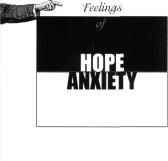
1. Briefly research early Cold War America, either in a United States history text, books from the library, or on the Internet. One option would be for each student to select or to be assigned an event, or to work in small groups using categories such as, political, economic, social, intellectual, and the arts. Specific topics could include (a) postwar economic adjustments, (b) the emergence of the Cold War, (b) the baby boom, (c) the House Un-American Activities Committee investigations and Joseph McCarthy, (d) blacklisting during the Eisenhower presidency, (e) the Sputnik crisis and its effect on American education, and (e) the emergence of civil rights as a national issue. Share your findings with the class in short oral reports. 2. Together, create a large graphic organizer that depicts these significant events. 3. Discuss how these events contributed to both feelings of hope and anxiety. Based on these national and international developments, why would education become even more important than before World War II? 10  Compiling data and writing a compare/contrast essay: Contrasting prime-time commercial broadcasting with public broadcasting. (This will involve at least three days.) 1. Watch three hours each of commercial prime-time (7-10 P.M.) commercial television (ABC, CBS, Fox, NBC) as well as three hours of PBS prime-time television. Note the following on each network: the names of the programs, program lengths, the number of commercials, the presentation styles, and the number of times you are told to do something. 2. After viewing both, write a five-paragraph essay that compares and contrasts the formats of both networks. Use specific examples from your viewing data to back up your conclusions. 3. Follow up the next class period with a whole-class discussion of their impressions of both networks. Be sure to cover both the similarities and differences the students observed.
11  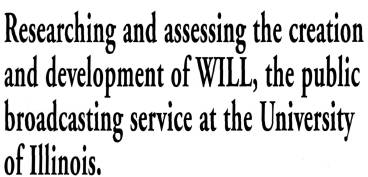 Utilizing the Internet, research WILL'S history. Draft a flow-chart of its history from 1920 to 2002. At what points in time was WILL pivotal to the development of public broadcasting in the United States? At what point was the system globalized? One website from which to start is www.will.uiuc.edu. 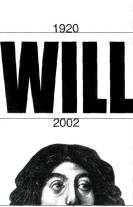
12 |
|
|